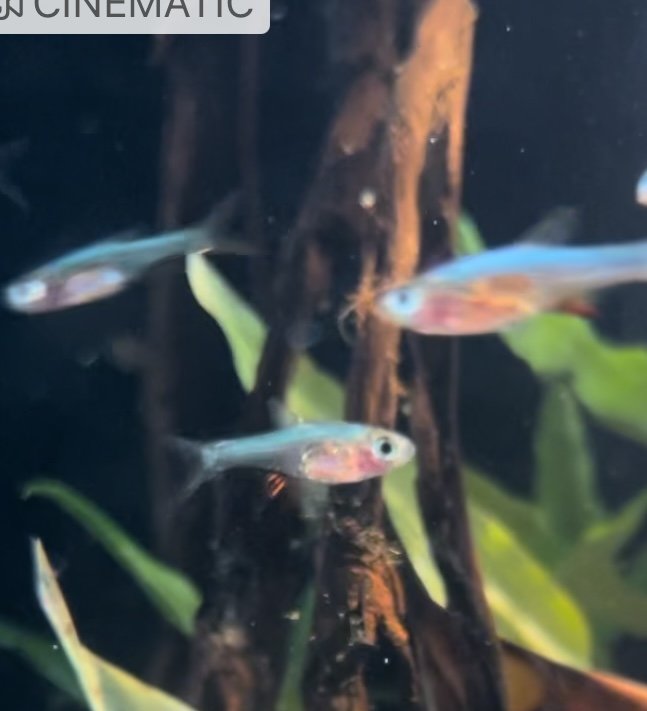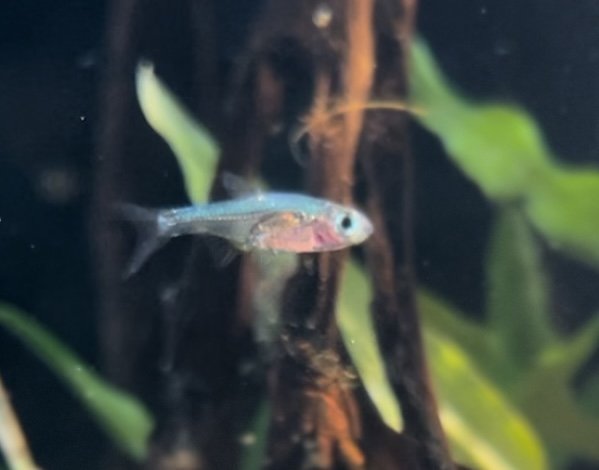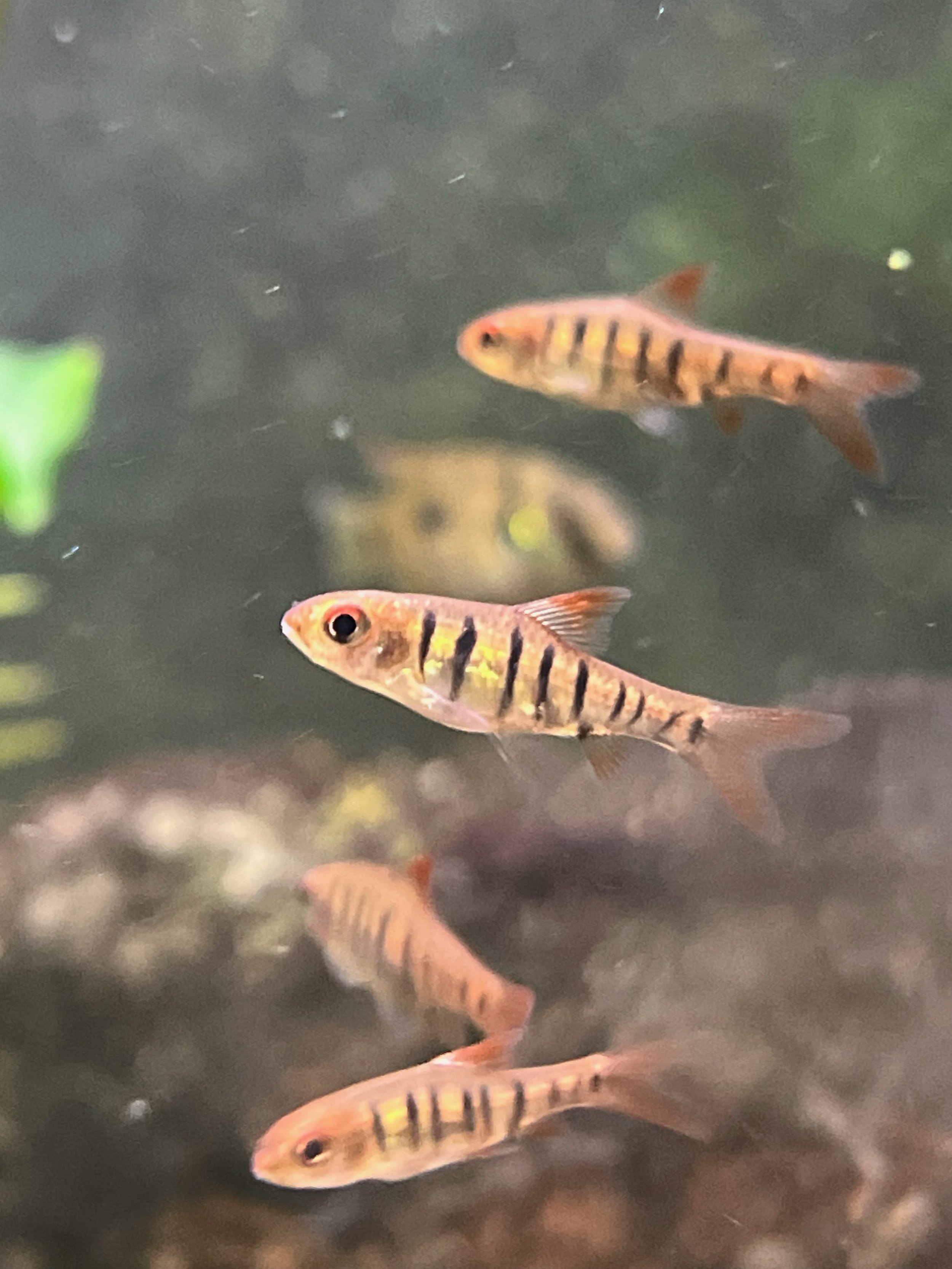 Image 1 of 2
Image 1 of 2

 Image 2 of 2
Image 2 of 2



Gold Barb
The Gold Barb, scientifically known as Barbodes semifasciolatus, is a vibrant and hardy freshwater fish that is native to Southeast Asia, particularly found in rivers and streams of southern China and Vietnam. Though the wild form has more subdued coloration, the popular golden variety, bred specifically for aquariums, has become a favorite for its brilliant golden-yellow color, peaceful demeanor, and ease of care. Gold Barbs are an excellent choice for beginner aquarists and make a lively addition to community tanks.
Physical Description:
The Gold Barb has an attractive golden-yellow body with slight hints of greenish hues along the top of the back. Some individuals may also display faint vertical banding or dark patches, particularly around the base of the dorsal fin. The fins are typically translucent with a reddish or orange tint, adding to their colorful appearance. Gold Barbs are relatively small, reaching an adult size of about 2.5 to 3 inches (6 to 7.5 centimeters), making them suitable for medium-sized tanks.
Aquarium Care:
Gold Barbs are active, schooling fish and should be kept in groups of at least six to reduce stress and encourage natural behaviors. A well-planted tank with open swimming spaces is ideal, as these barbs enjoy exploring and moving around the tank. Gold Barbs are relatively undemanding, but they thrive in aquariums with hiding spots created by driftwood, rocks, and plants. A tank size of 20 gallons or larger is recommended to accommodate their active nature and schooling behavior.
Water Parameters:
Gold Barbs are adaptable and can tolerate a range of water conditions, though they prefer slightly acidic to neutral water with a pH range of 6.5 to 7.5. They do well in temperatures between 68 to 77°F (20 to 25°C), making them suitable for both tropical and temperate setups. Regular water changes and filtration are essential to maintain water quality, as Gold Barbs are sensitive to high nitrate levels.
Feeding:
Gold Barbs are omnivorous and have a hearty appetite. They thrive on a varied diet that includes high-quality flakes or pellets, along with live or frozen foods such as brine shrimp, bloodworms, and daphnia. They also enjoy vegetable matter, so supplementing their diet with blanched vegetables like spinach or zucchini can help ensure balanced nutrition. A varied diet will enhance their color and keep them active and healthy.
Temperament and Tank Mates:
Gold Barbs are peaceful and get along well with other similarly sized, non-aggressive fish, making them ideal for community tanks. Suitable tank mates include other barbs (such as Cherry Barbs), tetras, danios, and peaceful bottom-dwellers like Corydoras catfish and loaches. Although they are generally peaceful, they may occasionally nip the fins of slow-moving, long-finned fish, so it’s best to avoid keeping them with species like bettas or guppies.
Breeding:
Breeding Gold Barbs in captivity is relatively straightforward, as they are egg scatterers. To encourage breeding, set up a separate breeding tank with fine-leaved plants or a spawning mop, where the female can scatter her eggs. Conditioning the pair with live or frozen foods can also encourage spawning. After spawning, remove the adults to prevent them from eating the eggs. The eggs will hatch in 24 to 48 hours, and the fry can be fed infusoria or specially prepared fry food until they are large enough to eat baby brine shrimp.
Overall:
The Gold Barb (Barbodes semifasciolatus) is a colorful, active, and easy-to-care-for fish that makes a wonderful addition to community aquariums. With their vibrant golden color, peaceful temperament, and hardy nature, they are ideal for aquarists of all experience levels. By providing a well-maintained environment, varied diet, and compatible tank mates, Gold Barbs can thrive and add lively movement and color to any freshwater aquarium.
The Gold Barb, scientifically known as Barbodes semifasciolatus, is a vibrant and hardy freshwater fish that is native to Southeast Asia, particularly found in rivers and streams of southern China and Vietnam. Though the wild form has more subdued coloration, the popular golden variety, bred specifically for aquariums, has become a favorite for its brilliant golden-yellow color, peaceful demeanor, and ease of care. Gold Barbs are an excellent choice for beginner aquarists and make a lively addition to community tanks.
Physical Description:
The Gold Barb has an attractive golden-yellow body with slight hints of greenish hues along the top of the back. Some individuals may also display faint vertical banding or dark patches, particularly around the base of the dorsal fin. The fins are typically translucent with a reddish or orange tint, adding to their colorful appearance. Gold Barbs are relatively small, reaching an adult size of about 2.5 to 3 inches (6 to 7.5 centimeters), making them suitable for medium-sized tanks.
Aquarium Care:
Gold Barbs are active, schooling fish and should be kept in groups of at least six to reduce stress and encourage natural behaviors. A well-planted tank with open swimming spaces is ideal, as these barbs enjoy exploring and moving around the tank. Gold Barbs are relatively undemanding, but they thrive in aquariums with hiding spots created by driftwood, rocks, and plants. A tank size of 20 gallons or larger is recommended to accommodate their active nature and schooling behavior.
Water Parameters:
Gold Barbs are adaptable and can tolerate a range of water conditions, though they prefer slightly acidic to neutral water with a pH range of 6.5 to 7.5. They do well in temperatures between 68 to 77°F (20 to 25°C), making them suitable for both tropical and temperate setups. Regular water changes and filtration are essential to maintain water quality, as Gold Barbs are sensitive to high nitrate levels.
Feeding:
Gold Barbs are omnivorous and have a hearty appetite. They thrive on a varied diet that includes high-quality flakes or pellets, along with live or frozen foods such as brine shrimp, bloodworms, and daphnia. They also enjoy vegetable matter, so supplementing their diet with blanched vegetables like spinach or zucchini can help ensure balanced nutrition. A varied diet will enhance their color and keep them active and healthy.
Temperament and Tank Mates:
Gold Barbs are peaceful and get along well with other similarly sized, non-aggressive fish, making them ideal for community tanks. Suitable tank mates include other barbs (such as Cherry Barbs), tetras, danios, and peaceful bottom-dwellers like Corydoras catfish and loaches. Although they are generally peaceful, they may occasionally nip the fins of slow-moving, long-finned fish, so it’s best to avoid keeping them with species like bettas or guppies.
Breeding:
Breeding Gold Barbs in captivity is relatively straightforward, as they are egg scatterers. To encourage breeding, set up a separate breeding tank with fine-leaved plants or a spawning mop, where the female can scatter her eggs. Conditioning the pair with live or frozen foods can also encourage spawning. After spawning, remove the adults to prevent them from eating the eggs. The eggs will hatch in 24 to 48 hours, and the fry can be fed infusoria or specially prepared fry food until they are large enough to eat baby brine shrimp.
Overall:
The Gold Barb (Barbodes semifasciolatus) is a colorful, active, and easy-to-care-for fish that makes a wonderful addition to community aquariums. With their vibrant golden color, peaceful temperament, and hardy nature, they are ideal for aquarists of all experience levels. By providing a well-maintained environment, varied diet, and compatible tank mates, Gold Barbs can thrive and add lively movement and color to any freshwater aquarium.
The Gold Barb, scientifically known as Barbodes semifasciolatus, is a vibrant and hardy freshwater fish that is native to Southeast Asia, particularly found in rivers and streams of southern China and Vietnam. Though the wild form has more subdued coloration, the popular golden variety, bred specifically for aquariums, has become a favorite for its brilliant golden-yellow color, peaceful demeanor, and ease of care. Gold Barbs are an excellent choice for beginner aquarists and make a lively addition to community tanks.
Physical Description:
The Gold Barb has an attractive golden-yellow body with slight hints of greenish hues along the top of the back. Some individuals may also display faint vertical banding or dark patches, particularly around the base of the dorsal fin. The fins are typically translucent with a reddish or orange tint, adding to their colorful appearance. Gold Barbs are relatively small, reaching an adult size of about 2.5 to 3 inches (6 to 7.5 centimeters), making them suitable for medium-sized tanks.
Aquarium Care:
Gold Barbs are active, schooling fish and should be kept in groups of at least six to reduce stress and encourage natural behaviors. A well-planted tank with open swimming spaces is ideal, as these barbs enjoy exploring and moving around the tank. Gold Barbs are relatively undemanding, but they thrive in aquariums with hiding spots created by driftwood, rocks, and plants. A tank size of 20 gallons or larger is recommended to accommodate their active nature and schooling behavior.
Water Parameters:
Gold Barbs are adaptable and can tolerate a range of water conditions, though they prefer slightly acidic to neutral water with a pH range of 6.5 to 7.5. They do well in temperatures between 68 to 77°F (20 to 25°C), making them suitable for both tropical and temperate setups. Regular water changes and filtration are essential to maintain water quality, as Gold Barbs are sensitive to high nitrate levels.
Feeding:
Gold Barbs are omnivorous and have a hearty appetite. They thrive on a varied diet that includes high-quality flakes or pellets, along with live or frozen foods such as brine shrimp, bloodworms, and daphnia. They also enjoy vegetable matter, so supplementing their diet with blanched vegetables like spinach or zucchini can help ensure balanced nutrition. A varied diet will enhance their color and keep them active and healthy.
Temperament and Tank Mates:
Gold Barbs are peaceful and get along well with other similarly sized, non-aggressive fish, making them ideal for community tanks. Suitable tank mates include other barbs (such as Cherry Barbs), tetras, danios, and peaceful bottom-dwellers like Corydoras catfish and loaches. Although they are generally peaceful, they may occasionally nip the fins of slow-moving, long-finned fish, so it’s best to avoid keeping them with species like bettas or guppies.
Breeding:
Breeding Gold Barbs in captivity is relatively straightforward, as they are egg scatterers. To encourage breeding, set up a separate breeding tank with fine-leaved plants or a spawning mop, where the female can scatter her eggs. Conditioning the pair with live or frozen foods can also encourage spawning. After spawning, remove the adults to prevent them from eating the eggs. The eggs will hatch in 24 to 48 hours, and the fry can be fed infusoria or specially prepared fry food until they are large enough to eat baby brine shrimp.
Overall:
The Gold Barb (Barbodes semifasciolatus) is a colorful, active, and easy-to-care-for fish that makes a wonderful addition to community aquariums. With their vibrant golden color, peaceful temperament, and hardy nature, they are ideal for aquarists of all experience levels. By providing a well-maintained environment, varied diet, and compatible tank mates, Gold Barbs can thrive and add lively movement and color to any freshwater aquarium.







